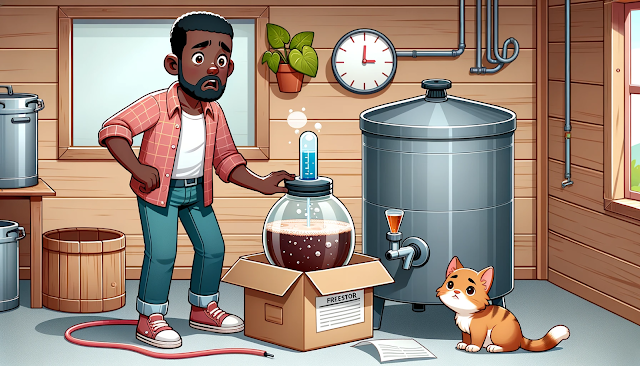So, the pressing question arises: why are there no bubbles rising out of the airlock?
One of the most common culprits behind a non-bubbling airlock is a simple leak.
Temperature can be a deceptive factor in brewing.
The Art and Science of Fermentation: Patience, Observation, and Adaptation
Fermentation is the heartbeat of brewing, a transformative process that turns wort into beer through the magical interplay of yeast and sugar. However, it’s not always a rapid or predictable process. Depending on various factors, it can take anywhere from 15 to 48 hours to show visible signs of activity. F
or novice brewers, this wait can feel agonizing, but before hitting the panic button, it’s important to understand the nuances of fermentation and what to look for.
The Waiting Game: Understanding Fermentation Activity
For those staring at an airlock, anxiously awaiting bubbles, it’s important to know that bubbles, while reassuring, aren’t the sole indicators of successful fermentation. Other signs can reveal whether your beer is on track.
One of the clearest indicators is the appearance of a dark, frothy scum or krausen around the water level of the fermenter. This krausen, a mix of yeast, proteins, and hop residues, often forms a sticky ring on the walls of the fermenter as fermentation progresses. Additionally, a foamy layer at the top of the beer is another positive sign of active fermentation. For brewers who choose to peek inside the fermenter to confirm activity, minimizing exposure to the outside environment is critical to avoid contamination.
These visible changes are worth celebrating—they indicate that the yeast is actively converting sugars into alcohol and CO2, the essential process at the heart of brewing. But what happens when these signs fail to appear?
Troubleshooting Fermentation Delays
Even after 48 hours, if there are no bubbles, krausen, or foam, it doesn’t necessarily mean your brew is doomed. There are a few common reasons why fermentation might stall or fail to begin.
1. Yeast Viability and Pitching Temperatures
Yeast is a living organism, and its health directly affects fermentation. Pitching yeast into wort that is too hot is one of the most common mistakes among beginner brewers. Yeast begins to die at temperatures above 104°F (40°C), and at higher temperatures, most cells will be destroyed outright. For optimal fermentation, wort should be cooled to the yeast’s recommended temperature range, typically between 68°F and 72°F for most ale yeasts.
If you suspect the yeast has been compromised—whether due to high temperatures or because the packet was old or improperly stored—it may be necessary to repitch with fresh yeast. Fresh, healthy yeast can revive a stalled batch and set the fermentation process back on track.
2. A Critical Oversight: Adding Yeast to Boiling Wort
A cardinal rule in brewing is to never add yeast to boiling wort. The high temperature will instantly kill the yeast, rendering it inactive before fermentation even begins. Always ensure your wort has cooled to a safe temperature before introducing yeast.
3. Sanitization Slip-Ups
Sanitization is paramount in brewing, but even the most meticulous brewers can make mistakes. Some cleaning agents, such as bleach, can leave harmful residues if not properly rinsed. These residues can inhibit yeast activity or even kill the yeast outright. Using no-rinse sanitizers specifically designed for brewing can help avoid this issue and ensure a clean, safe environment for fermentation.
The Role of the Airlock
The airlock is one of the brewer’s most iconic tools, but it’s worth understanding its purpose and limitations. An airlock allows CO2 to escape during fermentation while preventing contaminants like bacteria and wild yeast from entering. Properly filling the airlock is essential—too little water, and it may fail to function as intended. While water is the standard filling liquid, many brewers opt for vodka as an added safeguard against contamination.
But what if you don’t have an airlock? Historically, beer was brewed long before the invention of modern airlocks. In such cases, improvisation becomes key. Covering the fermenter with a sterilized cloth or paper towel can work as a temporary solution, though it requires extra vigilance to maintain a clean environment.
Observing Beyond Bubbles: A Master Brewer’s Perspective
For seasoned brewers, bubbles in the airlock are merely one data point among many. The absence of bubbles doesn’t necessarily indicate a problem. Airlock activity can sometimes be influenced by a poor seal or alternative pathways for CO2 to escape. Instead, expert brewers rely on sensory and visual cues to judge fermentation progress.
Krausen formation, foam, and even the smell emanating from the fermenter can reveal a great deal. A healthy fermentation often produces aromas ranging from fruity and estery to slightly sulfurous, depending on the yeast strain. Monitoring these subtleties, rather than fixating on bubbles, is a hallmark of an experienced brewer.
Patience and Adaptation: The Brewer’s Toolkit
The brewing process demands patience, observation, and a willingness to adapt. Fermentation delays are not uncommon, even for seasoned brewers, but they are rarely insurmountable. By understanding the variables—yeast health, pitching temperatures, sanitization practices, and environmental conditions—you can troubleshoot effectively and ensure your beer stays on course.
Remember that every batch is a learning experience. Detailed record-keeping, including notes on fermentation times, temperatures, and yeast handling, can help refine your process and prevent future issues.

